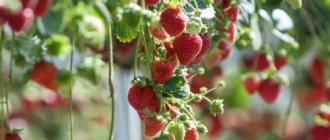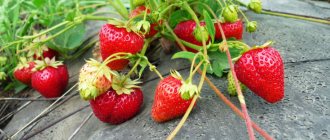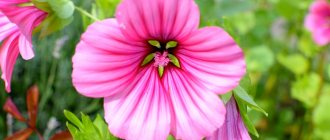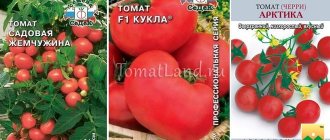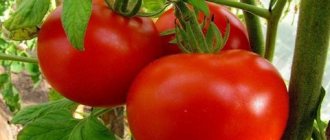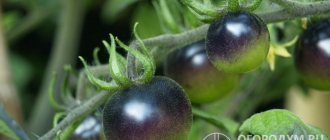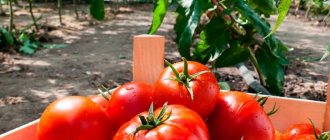Climbing varieties of strawberries, like the best varieties of strawberries, are grown for fruit production and as a decorative decoration for plots. Thanks to its unusual shape, it is used for decorations in garden plots, apartments and loggias, and at the same time brings a large harvest of berries.
Characteristics
With proper care, strawberries can produce consistently high yields.
Features and benefits of climbing strawberries:
- buds of peduncles are formed in addition to rosettes also on the mustache;
- vertical beds do not require frequent weeding;
- hanging berries do not touch the soil and do not rot;
- the berries are not accessible to some crawling pests, such as slugs;
- remontant (bearded) varieties predominate.
Climbing bushes with hanging red berries look very beautiful in the garden.
Vertical beds of various structures and flowerpots allow you to grow berries even on a terrace or in an apartment . Cons:
- if care and cultivation do not require special work, then preparation for wintering has a number of rules;
- the vertical arrangement of the beds requires more watering - once every 4 days, while regular strawberries can be watered once a week.
- Climbing strawberry varieties require frequent fertilization.
Preparing a climbing plant for winter
If the vertical beds of strawberries are not high, you can make a special protective structure for the winter from wooden slats, burlap, roofing felt, lutrasil or agril.
To prevent climbing strawberries from dying in the harsh conditions of the Russian winter, before the first frost, you must perform the following steps :
- If possible, the best way to overwinter such plants would be to move them to a cool room ;
- When growing strawberries in hanging pots , they are removed, dug into the ground and covered with burlap, spruce branches, hay or other material;
- If the strawberry grew on a vertical structure , it will need to be removed and the tendrils laid on the ground. Then it is also covered with any available material.
When tying plant tendrils to a trellis or fence, you need to think about their mobility in advance, because if they remain overwintering in an upright position, they will most likely die.
Best types: 5 varieties
All types of this climbing berry belong to ampelous plants - crops that can grow in hanging pots, flowerpots, and cache-pots. I will describe the most popular varieties and reviews about them:
| Temptation Appearance:
Fruit:
Bears fruit throughout the summer and early autumn. High yields are maintained for up to three years. High-yielding variety. During the season it produces up to 1.5 kg of large berries. Brief characteristics of the variety:
“Temptation not only grows in my dacha, I planted it in my apartment, in pots. Growing strawberries this way turned out to be very simple, due to the fact that the variety is unpretentious and takes root well.” | |
| Fresco Appearance:
Fruit:
It bears fruit for a long time - from June to the end of September. High yield. In the first year - 1 kg of berries per bush per season, in subsequent years - up to 2 kg. Brief characteristics of the variety:
“The variety is absolutely unpretentious to growing conditions and soil type, and adapts perfectly to any climate. Requires standard care for strawberries. Only fertilizing should be more abundant and frequent, since the plants spend a lot of energy on constant fruiting (remontant variety).” | |
| Queen Elizabeth Appearance:
Fruit:
Productivity - up to 2 years. The fruiting period is from the end of May to the end of September. In closed ground it can bear fruit throughout the year. Large harvest - up to 4 kg per season, in protected greenhouse conditions - up to 10 kg. Brief characteristics of the variety:
“I’m growing this variety for the first season. So far I like everything. The bush is powerful, densely leafy. There are no diseases or pests. The learning ability is good. The berry is very large, dense, good taste" | |
| Tarpan Appearance:
Fruit:
Bears fruit from June to October. Productivity is high - the first fruiting is large berries. Ampelous appearance, can be grown in hanging baskets in an apartment. Brief characteristics of the variety:
“Good for preservation. It does not crack either on bushes or in a jar. Quite unpretentious, not painful. The binding in hot weather is good. Fruit until frost. Keeping quality is good" |
Transplantation into open ground
Strawberries on a high bed
Planting ampelous strawberries in an open place is done at the same time as transplanting them into decorative containers, but it is first important to correctly determine the location for the plant. The best option is an area in the southwestern part of the garden or vegetable garden, which is well lit by the sun and ventilated, but without strong winds and drafts. The place should be on a slight elevation - if there is none, you can build high beds with your own hands.
Climbing strawberries are planted separately from other crops
Special requirements are placed on the soil - its acidity should be in the range of 5.7-6.2 pH, and the depth of groundwater should be about 80 cm. If the soil is too wet, it is recommended to drain it - excessive amounts of moisture will cause the plantings to become sick and can quickly die.
The bushes are planted at a distance of 30-35 cm from each other, after which they need to be lightly buried with earth and watered abundantly. If it is very hot outside when planting a plant, the plantings should be protected from the sun for about a week. When growing ampelous strawberries in open ground, the tendrils can be allowed to spread freely along the surface of the soil or tied to a lattice structure or fence.
Attention! The ampelous variety of the crop cannot be planted next to the usual garden variety, since these crops are poorly compatible with each other.
Strawberry care: 5 rules
Climbing strawberry is not a particularly picky berry. But without following certain rules, you will not get a good harvest:
| Rule 1. Watering Young seedlings need frequent watering:
A convenient method of constant water replenishment in small portions is drip irrigation. To prevent the soil from drying out quickly, it needs to be mulched after watering. | |
| Rule 2. Feeding Remontant climbing garden strawberries (strawberries) constantly bear fruit. She needs a lot of nutrients to maintain her strength. It is necessary to replenish microelements in the soil by regularly applying fertilizers:
Fertilizers are applied at the root after watering once a week. | |
| Rule 3. Trimming mustaches and peduncles Cut off all flower stalks of first-year seedlings. The plant will devote strength to the formation of roots, and prepare for fruiting next year. For mature bushes, leave no more than 5 flower stalks. After the last harvest, cut off all the leaves; this procedure will renew the berry bush. | |
| Rule 4. Pest and disease control Climbing strawberries are not so susceptible to attack by insects and animals, since they are not on the ground. The berry can be “attacked” by:
Attention! For preventive purposes, irrigate the soil with copper sulfate in spring and autumn. | |
| Rule 5. Protection in winter Preparation for winter is carried out in several ways. Method 1:
Method 2:
Method 3:
|
Important! Weeding and loosening are not the main thing in caring for strawberries of hanging varieties, but it is necessary to remove emerging weeds. At the same time, fluff up the compacted soil to give oxygen access to the roots. Carry out actions after watering.
Diseases and pests
Climbing strawberries are moderately resistant to both diseases and pests. Most often you can find strawberry mites, nematodes or fungal diseases on it .
- Under the influence of the strawberry mite, the berries become much smaller and gradually wither. You can get rid of such pests using chemicals such as Nero, Fufanon, etc. For the best effect, three treatments are carried out with an interval of 7-10 days;
- When nematodes occur , the berries become tough and the stems become thick and short. In this case, the plant cannot be treated. It will need to be dug up and burned;
- Various types of fungicides are usually used to combat fungal diseases
Strawberry mite
Fungal disease of strawberry leaves
Strawberry nematode
To protect strawberries from various kinds of problems, it is necessary to properly care for them and carry out preventive treatments with Brodka liquid twice a season (spring and autumn).
Climbing strawberries are a very unusual plant , thanks to which you can give a new look to any garden plot or room.
Reproduction: 2 ways
| Method 1. Reproduction by mustache To produce young trees, strong bushes with good fruiting are used:
| |
Method 2. Reproduction by rosettes
|
General rules for vertical planting
The requirements for all types of vertical planting are the same. They are in many ways the same as on regular plantations, but there are some differences.
Lighting
The strawberries are located in a well-lit place; the bushes should not shade each other. Although the berry tolerates a little shade - for a short time (for example, in the morning or evening) or in the diffuse shade of a sparse tree crown. But the more sun and warmth, the more sugars in the berry and the better the taste. And in the shade the berries are sour and small.
The more sun, the sweeter the strawberries
Required volume of soil and watering
Having chosen the type of planting, you need to know the feeding area and the volume of soil that is needed for each individual strawberry bush in any vertical type structure. This is approximately 3-5 liters of soil, or the volume of a pot 18-20 cm in diameter and 20-25 cm deep - this is the depth at which the main root system of strawberries is located during normal planting on the ground.
Remember
- Select good seedlings. When choosing planting material, do not skimp. It is better to buy strong seedlings that can take root well. Discard dry, wilted seedlings - these are diseased plants.
- For propagation, take tendrils from plants that are 2–3 years old. Old bushes are not capable of producing good planting material.
- Renew the beds. Replace 3-4 year old strawberry bushes with young plantings to get a bountiful harvest.
- Know how to reproduce. There are two ways to get new strawberry seedlings - by separating rosettes and tendrils.
Vertical planting of strawberries: types, methods, advantages and disadvantages of the method
During normal planting, strawberries (garden strawberries) occupy significant areas. And caring for it, including harvesting, is one of the most labor-intensive and inconvenient of all garden crops. Therefore, many are interested in alternative planting methods - on high ridges, in areas covered with mulching film with slots, on racks. One of the best, according to the accumulated experience of gardeners, is the vertical planting method.
Planting material for vertical beds
For vertical beds use:
Rooted mustache
Immediately after fruiting, strawberries on ordinary plantations sprout a mustache. Sometimes they themselves, touching loose, damp soil, form roots. And to obtain a large amount of planting material, the mustache is deliberately sprinkled with earth. By August, the rooted mustaches become full-fledged planting material. They can already be planted in vertical structures at this time so that they have time to take root well before next spring.
Immediately after fruiting, strawberries sprout tendrils that take root in the ground
You can plant last year's rooted mustache in the spring. In any case, the first harvest will only be next year, and this is a big disadvantage of this method. The construction, which is labor- and cost-intensive, will run idle for a year. The exception is remontant strawberries. It may begin to bear fruit towards the end of the first year's season.
Mature bushes
There is experience when an ordinary strawberry plantation is kept in vertical structures specifically for propagation of planting material. It can grow in a continuous carpet even without special care and expectation of harvest, but from there you can always dig up and transplant an adult bush into vertical structures. If you transplant a bush from a regular plantation in early spring, it will produce a harvest this year. Strawberries need to be dug up with a clod of earth, trying not to damage the roots, and without delay, according to the principle “from the ground straight into the ground.” And then the first harvest will be this same summer.
Seedling
If you plant your favorite variety of garden strawberries with seeds in December or January, and in the spring you plant the seedlings in a vertical structure, you will have a harvest in the first year. If you plant the seeds later, you will have to wait an extra year for the harvest (except for remontant strawberries). In spring you can also buy ready-made seedlings in nurseries and specialty stores. But then you definitely need to ask the sellers what kind of variety it is, how it is propagated, by seeds or runners, what age it is, and so on.
Strawberry seedlings for planting in vertical structures must be strong and healthy
